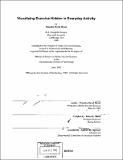Visualizing exercise hidden in everyday activity
Author(s)
Hirzel, Timothy David, 1977-
DownloadFull printable version (10.09Mb)
Other Contributors
Massachusetts Institute of Technology. Dept. of Architecture. Program In Media Arts and Sciences.
Advisor
Brian K. Smith.
Terms of use
Metadata
Show full item recordAbstract
Obesity in the United States has reached epidemic proportions and inactivity is a key factor in this health problem. One difficulty in promoting an active lifestyle is the idea that getting enough "exercise" means jogging, going to the gym, or riding an exercise bike for half and hour every day. While these activities are helpful, they can be daunting for an inactive person and difficult to plan into a busy schedule. Alternatively, many regular activities such as using stairs or walking to work can also provide healthy exercise. To bring attention to the exercise present in everyday activities, I created visualizations of full-time measurements of heart rate. These visualizations were designed to improve a person's sense of control over physical fitness. They show how everyday activities can accumulate into significant amounts of exercise. I conducted a pilot test of this device on a small number of subjects. These tests indicate that feedback of all-day heart rate measurements may lead to changes in beliefs about exercise.
Description
Thesis (S.M.)--Massachusetts Institute of Technology, School of Architecture and Planning, Program in Media Arts and Sciences, 2002. Includes bibliographical references (p. 69-71).
Date issued
2002Department
Program in Media Arts and Sciences (Massachusetts Institute of Technology)Publisher
Massachusetts Institute of Technology
Keywords
Architecture. Program In Media Arts and Sciences.